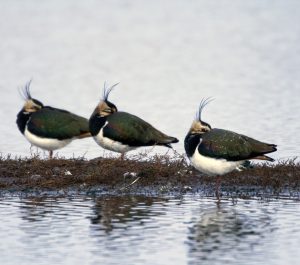Lapwings
Breeding Lapwings are now quite scarce in the UK, unless landowners makes a real effort to host them.
Lapwings have declined because of predation and lack of food. Their food being insects in the soil. Their predators - Foxes, Badgers, Buzzards, Kites, Marsh Harriers, Ravens, and Carrion Crows, are all species that have increased during the past 30 years. If the Lapwings are nesting near water, Herons are also a big predator. Controlling predators is not simple and many of the predators are protected anyway.
Lapwings will only nest where they can have good all-round vision from their nest, so that would mean in a spring grown crop or grazed grass. In both cases, the Lapwing nest could be destroyed by tractors or grazing animals, but as we do far more spraying than cultivating in our spring grown crops, nests being destroyed by tractors happens less than it used to.
There is less food in our soil because every time we plough and cultivate, we kill invertebrates, whether it be worms, beetles, millipedes, or others. There is also less food in our pastures, as they are less diverse than they used to be.
To provide more food we need a diverse pasture, with wet areas. On arable land, the best way of increasing invertebrates in the soil is to direct drill a winter cover crop and direct drill the following spring crop. On every field we have done this, we have had Lapwings nesting on those fields. Not always successful in rearing young, but that certainly is a way of increasing the invertebrates in the soil. Having provided the food in the soil, breeding Lapwings won’t visit unless they are breeding locally.
Lapwings return to breed on the same colour field that they were brought up on, so those that have been brought up on a spring crop do not readily go and nest on a grass field and vice versa.
Like many of the birds we so love to see, the prospects of breeding Lapwings in this modern world are not good.
Lapwings have declined because of predation and lack of food. Their food being insects in the soil. Their predators - Foxes, Badgers, Buzzards, Kites, Marsh Harriers, Ravens, and Carrion Crows, are all species that have increased during the past 30 years. If the Lapwings are nesting near water, Herons are also a big predator. Controlling predators is not simple and many of the predators are protected anyway.
Lapwings will only nest where they can have good all-round vision from their nest, so that would mean in a spring grown crop or grazed grass. In both cases, the Lapwing nest could be destroyed by tractors or grazing animals, but as we do far more spraying than cultivating in our spring grown crops, nests being destroyed by tractors happens less than it used to.
There is less food in our soil because every time we plough and cultivate, we kill invertebrates, whether it be worms, beetles, millipedes, or others. There is also less food in our pastures, as they are less diverse than they used to be.
To provide more food we need a diverse pasture, with wet areas. On arable land, the best way of increasing invertebrates in the soil is to direct drill a winter cover crop and direct drill the following spring crop. On every field we have done this, we have had Lapwings nesting on those fields. Not always successful in rearing young, but that certainly is a way of increasing the invertebrates in the soil. Having provided the food in the soil, breeding Lapwings won’t visit unless they are breeding locally.
Lapwings return to breed on the same colour field that they were brought up on, so those that have been brought up on a spring crop do not readily go and nest on a grass field and vice versa.
Like many of the birds we so love to see, the prospects of breeding Lapwings in this modern world are not good.



